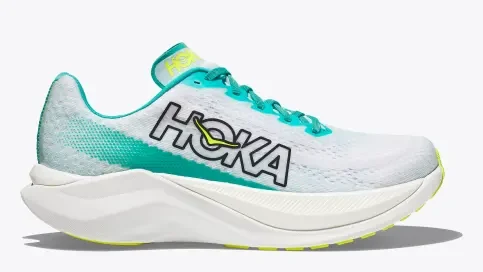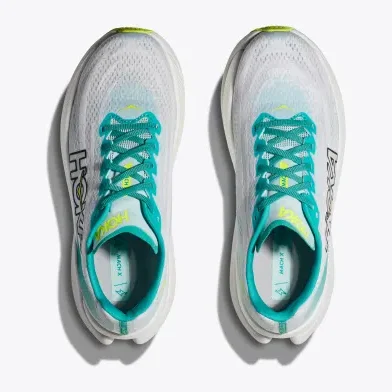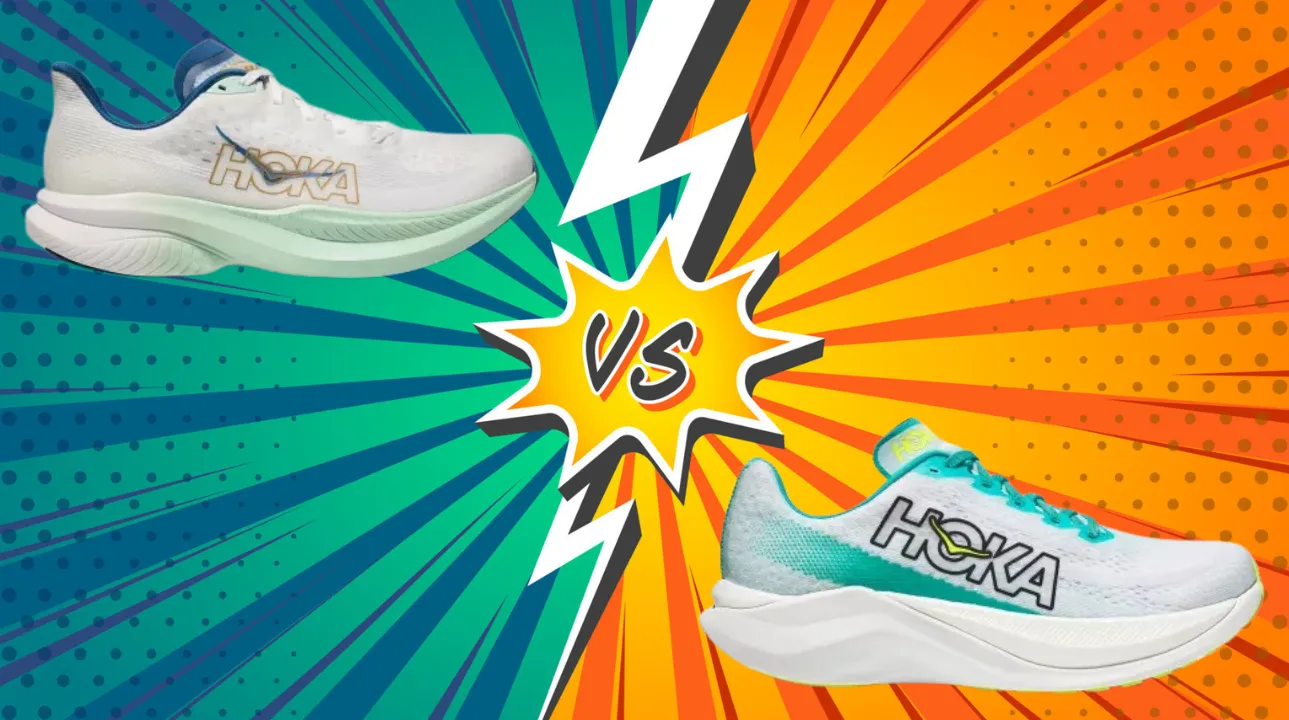Lace up, runners! We’re diving into an exciting face-off between two of Hoka’s top-tier running shoes: the Mach X and Mach 6. Both designed for everyday runs and races, these shoes promise to elevate your performance.
But which one will cross the finish line first in our comparison? Let’s hit the ground running and explore the unique features, performance, and value of these cutting-edge running companions.
Key Takeaways:
- Technology Edge: The Mach X features advanced ProFlyX™ midsole with PEBA foam and a Pebax® plate, offering superior responsiveness and energy return. The Mach 6 uses super critical foam, providing a more traditional yet effective cushioning experience.
- Weight Difference: At 8.20 oz, the Mach 6 is significantly lighter than the 9.40 oz Mach X. This weight difference may be noticeable during longer runs, potentially reducing fatigue for Mach 6 wearers.
- Price Point: The Mach X comes with a higher price tag of $180, reflecting its advanced technologies. The Mach 6, priced at $140, offers a more budget-friendly option without sacrificing Hoka’s core features and quality.
- Sustainability: The Mach X incorporates more eco-friendly materials, including recycled polyester in its upper, laces, and lining. This makes it a better choice for environmentally conscious runners seeking sustainable footwear options.
- Performance Focus: The Mach X is geared towards speed and race performance with its responsive plate technology. The Mach 6 offers a more versatile platform, suitable for daily training and a variety of running distances.
Comparison Table between Hoka Mach X And Hoka Mach 6:
| Feature | Hoka Mach X | Hoka Mach 6 |
|---|---|---|
| Stability | Neutral to Stable | Neutral to Stable |
| Flexibility | Moderate | Moderate |
| Sizing | True to size | True to size |
| Weight | 9.40 oz | 8.20 oz |
| Cushion | Responsive to Balanced | Responsive to Balanced |
| Outsole | Strategic rubber coverage | Strategic rubber coverage |
| Midsole | ProFlyX™ with PEBA foam | Super critical foam |
| Upper | Creel jacquard | Creel jacquard |
| Retail Price | $180 | $140 |
Features Comparison:
1. MATERIAL: outsole, insole, upper sole
The Hoka Mach X boasts a cutting-edge design with its ProFlyX™ midsole and highly resilient PEBA foam, providing a responsive and energetic ride.
The upper is crafted from a creel jacquard material, with 84% recycled polyester and 16% recycled nylon, showcasing Hoka’s commitment to sustainability.


The Mach 6 also features a creel jacquard upper but utilizes a super critical foam midsole for a different cushioning experience.
Both shoes incorporate strategic rubber outsole coverage for durability and traction, but the Mach X’s eco-friendly approach extends to its 87% recycled polyester strobel board and 40% recycled polyester eyestay lining.
2. Durability:
When it comes to durability, both the Mach X and Mach 6 are built to last. The Mach X’s use of PEBA foam in the midsole is known for its resilience and ability to maintain its properties over time.
The strategic rubber outsole coverage on both models helps protect high-wear areas, extending the shoes’ lifespan. However, the Mach X’s incorporation of a Pebax® plate (with 65% bio-based content) may provide additional structural integrity and longevity.
The Mach 6, while also durable, might have a slight edge in terms of lightweight design, which could potentially reduce overall wear and tear during long runs.
3. Fit:
Both the Mach X and Mach 6 are designed to provide a comfortable and secure fit. The Mach X features a gusseted upper construction, which helps create a snug, sock-like fit that adapts to the foot’s shape.
This design potentially offers better lockdown and prevents in-shoe slippage. The Mach 6, on the other hand, boasts a dual internal gusset and an anatomical tongue, which work together to provide a personalized fit.
The Mach 6 also includes a streamlined collar foam package, which may offer enhanced comfort around the ankle area. Both shoes are true to size, but the specific upper designs may cater to slightly different foot shapes or preferences.
4. Cushioning:
Cushioning is where these two models diverge significantly. The Mach X utilizes the innovative ProFlyX™ midsole combined with highly resilient PEBA foam, creating a responsive yet cushioned ride.
The addition of a propulsive Pebax® plate further enhances energy return, potentially giving the Mach X an edge in terms of speed and efficiency. The Mach 6 employs a super critical foam midsole, which is designed to provide a balance of cushioning and responsiveness.
Both shoes feature a low-profile cushion bed that keeps the foot closer to the ground, but the Mach X’s PEBA foam and plate technology may offer a more dynamic and energetic feel underfoot.
5. Stability:
Both the Mach X and Mach 6 are classified as neutral to stable shoes, designed to provide support without overly prescriptive technologies. They feature a symmetrical bed of cushion that aims to offer the right amount of stability for most runners.
The Mach X’s inclusion of a Pebax® plate may provide additional torsional rigidity, potentially enhancing stability during faster runs or races.


The Mach 6, while lacking the plate, may offer a more flexible ride that some runners might find more natural.
Ultimately, both shoes strike a balance between support and freedom of movement, catering to runners who don’t require significant corrective features.
6. Value for Money:
When considering value for money, it’s essential to weigh the features against the price point. The Mach X, priced at $180, is the more expensive option but comes with advanced technologies like the PEBA foam, Pebax® plate, and numerous eco-friendly materials.
These features may justify the higher price for runners seeking top-tier performance and sustainability. The Mach 6, at $140, offers a more budget-friendly option without sacrificing quality.
It provides many of Hoka’s signature features, including the super critical foam midsole and strategic outsole design. For runners who don’t need the additional propulsion of the plate or the specific eco-friendly materials, the Mach 6 represents excellent value.
Performance Comparison:
1. For Walking:
For walking, both shoes offer comfort and support, but their designs cater to slightly different preferences. The Mach X’s PEBA foam and Pebax® plate provide a more responsive feel, which some walkers might find energizing for longer distances.
Its slightly heavier weight (9.40 oz) could offer more stability during casual strolls. The Mach 6, being lighter (8.20 oz), might feel more nimble and less fatiguing during extended walking sessions.
Its super critical foam midsole offers a balanced cushioning that many walkers would appreciate. Both shoes provide ample cushioning for all-day comfort, making them suitable for various walking scenarios.
2. For Running:
When it comes to running, the differences between these models become more pronounced. The Mach X, with its ProFlyX™ midsole and propulsive Pebax® plate, is engineered for speed and efficiency.
It’s likely to excel in faster-paced runs and races, offering excellent energy return and a more responsive feel. The Mach 6, while still performance-oriented, provides a more traditional running experience with its super critical foam midsole.
It’s lighter weight might be preferable for longer distances where every ounce counts. Both shoes feature a 5mm heel-to-toe drop, promoting a natural running gait. For competitive runners or those focused on speed, the Mach X might have an edge, while the Mach 6 could be the go-to for versatile, everyday training.
3. Standing All Day:
For those who spend long hours on their feet, both models offer substantial comfort, but with different approaches. The Mach X’s PEBA foam is known for its durability and consistent cushioning over time, which could be beneficial for all-day wear.
The added structure from the Pebax® plate might provide additional support during prolonged standing. The Mach 6’s lighter weight and super critical foam midsole could offer a more cloud-like feel that some might prefer for extended periods of standing.
Its streamlined collar foam package might also provide extra comfort around the ankle area. Both shoes’ neutral to stable design helps maintain proper alignment, making them suitable choices for those who stand for long durations.
4. Plantar Fasciitis:
When it comes to addressing plantar fasciitis, both shoes offer features that could provide relief, but they approach it differently. The Mach X’s ProFlyX™ midsole combined with the Pebax® plate creates a firmer, more supportive platform that might help reduce stress on the plantar fascia.
The responsive cushioning could also aid in promoting a more efficient gait cycle. The Mach 6, with its super critical foam midsole, offers a softer, more shock-absorbing experience that some plantar fasciitis sufferers might find soothing.
Both shoes’ low 5mm drop encourages a midfoot strike, which can be beneficial for those with this condition. Ultimately, the choice between the two for plantar fasciitis would depend on whether the individual finds more relief from firmer support (Mach X) or softer cushioning (Mach 6).
Conclusion:
Choosing between the Hoka Mach X and Mach 6 boils down to your running style and priorities. The Mach X, with its advanced PEBA foam and Pebax® plate, caters to speed demons and tech enthusiasts willing to invest $180 for cutting-edge performance.
It shines in faster-paced runs and races, offering superior energy return. The Mach 6, priced at $140, presents a more versatile option for everyday training. Its lighter weight and super critical foam midsole provide a balanced, comfortable ride suitable for various distances.
Both shoes offer Hoka’s signature cushioning and support, but the Mach X edges ahead in responsiveness while the Mach 6 wins on versatility and value. Consider your running goals, preferred feel, and budget to make the best choice for your feet.

